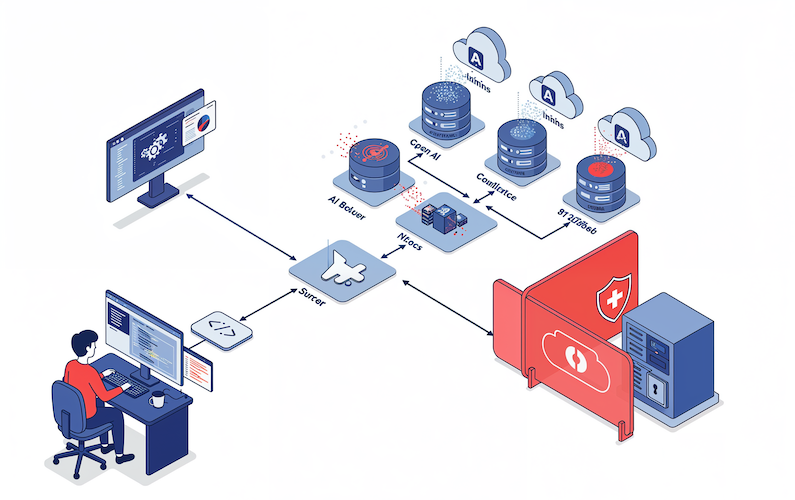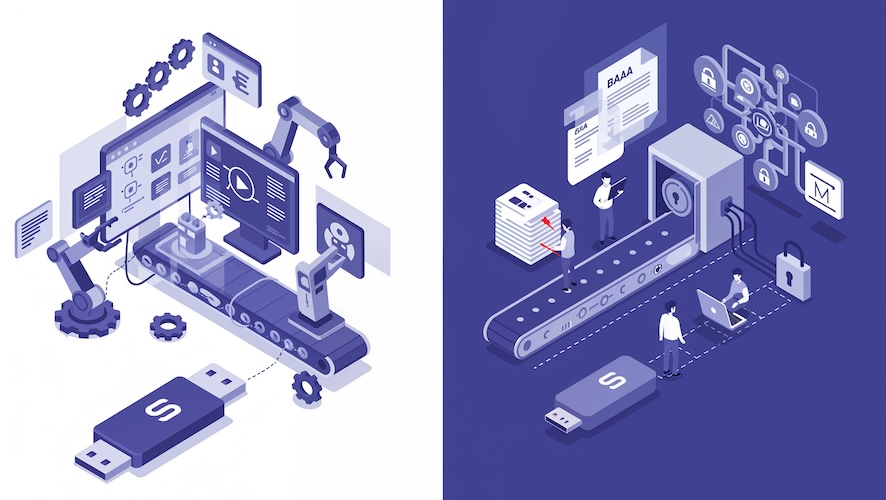Building a Healthcare App with Cursor? Read This Before You Touch PHI
You’re here because the math in your head sounds tempting: let Cursor scaffold screens, refactor services, generate tests, flip Privacy Mode on, and promise “no PHI in prompts.” Faster ship, right? Meanwhile, your compliance lead wants to know who signs the BAA, and your CEO wants an actual date on the launch calendar.
This post is your reality check. Cursor’s speed is real, but its data path runs through Cursor’s own backend and multiple model vendors; without an unbroken chain of BAAs, you’re building on sand, not rails.
If PHI is in scope from day one, the saner path is assembling on HIPAA-ready rails—telehealth, scheduling, messaging, claims, analytics—so you’re shipping features, not policies, and you keep the whole codebase.
Key takeaways
- Cursor accelerates coding, but the moment PHI can touch the toolchain, lack of end-to-end BAAs and multi-vendor routing turn speed into risk.
- In healthcare, time saved writing code is often erased by time lost to BAAs, audits, and re-architecture—TCO flips only when the platform is HIPAA-ready by default.
- Specode pairs composable, HIPAA-ready modules with a healthcare AI builder—so you assemble workflows fast, keep full code ownership, and maintain velocity when compliance and integrations show up.
What Cursor Is (and Isn’t) for Healthcare
Cursor is, at its core, a super-charged fork of VS Code. It bolts on AI agents, repo-aware chat, multi-file edits, and an à-la-carte pricing model. It can index your entire codebase, run autonomous “background agents” to scaffold boilerplate or refactor services, and even enforce coding rules (“never log PHI”) via built-in guardrails. For non-regulated builds, that’s developer catnip.

But here’s what it isn’t: a HIPAA-ready platform — if PHI is in scope, start with the leanest stack to build compliant healthcare apps. By design, every AI request flows through Cursor’s own AWS infrastructure before hitting external LLM providers such as:
- OpenAI
- Anthropic
- Fireworks
- xAI
There’s no self-hosted edition, no direct-route to your enterprise Azure OpenAI, and—most critically—no Business Associate Agreement. Privacy Mode can block long-term storage, but it doesn’t stop in-memory processing or third-party transmission. Under HIPAA, that’s still “receiving” PHI, which legally triggers the BAA requirement.
Cursor’s SOC 2 Type II badge is a nice signal for general security hygiene, but it’s not a HIPAA hall pass. Without an unbroken chain of BAAs covering every subprocessor, the compliance gap isn’t theoretical—it’s baked into the architecture.
So yes, Cursor has a place in a healthcare build—as long as you’re not touching anything re-identifiable. It’s excellent for:
- Spinning up SDKs
- Running test-first loops
- Generating HL7/FHIR parsers with synthetic data
If you’re touching real PHI, you’re not just bending the rules—you’re breaking them. And in healthcare, that’s a rebuild waiting to happen.
HIPAA Reality Check for AI Coding Tools
“Privacy Mode” and “zero-retention” sound reassuring on a marketing page—but under HIPAA, those switches don’t get you off the hook.

The U.S. Department of Health and Human Services (HHS) is explicit: if a vendor creates, receives, maintains, or transmits electronic protected health information (ePHI) on your behalf, they’re your Business Associate. Period. That applies even if the data is encrypted and the vendor never sees the key.
Which means:
- If an AI editor processes a prompt containing patient identifiers—even fleetingly—it’s “receiving” PHI.
- If that editor (or any of its model providers) isn’t under a signed BAA, you’ve just created a compliance violation.
Why “Zero-Retention” ≠ BAA
A “zero-retention” or “privacy” setting is a technical choice about storage. HIPAA status is a contractual designation based on the role a vendor plays in handling PHI. You can delete data instantly and still be a Business Associate the moment you transmit it.
HHS Guidance in Plain English
- BAAs aren’t optional when PHI flows into a vendor’s infrastructure.
- The HIPAA Security Rule applies directly to Business Associates—meaning your AI editor and every downstream model provider must implement administrative, physical, and technical safeguards.
- Without an unbroken chain of BAAs, the compliance risk flows straight back to you.
Remember that AI toolchains have plenty of quiet leak paths beyond the chat box—indexed repos, plugin calls, telemetry logs, crash reports. Even a synthetic-looking dataset can cross the PHI line if it’s re-identifiable in context.
Bottom line: the moment there’s a plausible path for PHI into your editor, embeddings, or logs, you need a fully BAA-covered stack—editor, model host, telemetry vendors, the works. If the vendor can’t give you signed BAAs and a clear data-flow map, keep them out of your regulated workflows.
Risk Map: Building with Cursor in a Regulated Context
When you run Cursor inside a regulated environment, you’re not just using an IDE — you’re introducing an entire AI supply chain into your workflow. Each AI-assisted keystroke moves through a chain of vendors, subprocessors, and data flows that may be invisible to your engineering team but are critical for HIPAA compliance.

The Real Data Path
A typical AI request in Cursor starts on the developer’s machine, passes through Cursor’s AWS-hosted backend, and is routed to one or more AI model providers — OpenAI, Anthropic, Google Gemini (via Vertex), or Fireworks.ai — regardless of which model you’ve selected in the UI.
If indexing is enabled, embeddings and metadata are persisted in Turbopuffer; if web search is invoked, Exa and SerpApi see the derived queries. Even with Privacy Mode on, code and prompt data is still transmitted in real time to these subprocessors — and without a BAA in place, that’s a compliance fault line.
Why “Privacy Mode” Isn’t a Shield
Privacy Mode is designed to protect intellectual property, not regulated data. It deletes code after processing and prevents training use — but it also erases the durable audit trails HIPAA’s Security Rule requires.
There’s still transient, in-memory exposure to non-BAA-covered vendors, which is enough to trigger a HIPAA violation if PHI is present. Cursor’s “zero-retention agreements” with model providers are contractual assurances about storage, not legally binding BAAs covering PHI use and disclosure.
Vendor Chain Risks
Cursor’s subprocessor network creates multiple exposure points:
- Inference providers (OpenAI, Anthropic, Google, Fireworks) — No BAAs, transient PHI exposure possible.
- Indexing storage (Turbopuffer) — Persistent embeddings; academic work shows partial reversibility risk.
- Logging/analytics (Datadog, MongoDB) — May capture prompt/code snippets if Privacy Mode is off.
- Search providers (Exa, SerpApi) — Receive queries derived from code or PHI-containing context.
Without contractual “chain of trust” BAAs down to the last subprocessor, HIPAA compliance breaks at the first transmission.
Guardrails in a Regulated Context
If your team evaluates Cursor before securing a BAA (unlikely given its current stance), enforce a zero-PHI engineering discipline:
- Use synthetic or fully de-identified datasets.
- Disable codebase indexing and web search.
- Mandate Privacy Mode and block non-Privacy Mode accounts via enterprise settings.
- Harden CI/CD pipelines to prevent PHI injection into prompts.
- Maintain an internal audit trail for all AI-assisted changes.
In short: Cursor’s productivity upside comes with a compliance downside that can only be neutralized by eliminating PHI entirely from the equation — or by selecting a HIPAA-ready alternative designed for healthcare app development.
Specode’s Alternative: Composable, HIPAA-Ready Components
If Cursor is an AI-powered workshop with the doors wide open, Specode is a turnkey factory floor—HIPAA-locked from day one and stocked with every major healthcare feature you’re likely to need.

Instead of wiring together auth flows, consent tracking, audit logs, and PHI storage from scratch, Specode gives you a library of pre-built, reusable components that snap together fast:
- Telehealth (video visits, scheduling, messaging)
- Secure patient onboarding & e-signature
- Claims & billing modules
- Lab ordering & biometric data sync
- AI-assisted EMR workflows for notes, prescriptions, and results
- Community and patient engagement tools
All of it arrives with compliance baked in—access controls, audit trails, encryption, and breach-response workflows already in place. And unlike most whitelabel platforms, you keep full code ownership. Build your app, deploy it, and walk away with 100% of the source code in your repo.
Integrations:
- Canvas Medical EHR: available out-of-the-box
- Other major EHRs, e-Rx partners, and lab APIs: integrated case-by-case via middleware (e.g., Mirth) or direct APIs—without derailing your launch timeline.
This approach means you can go from concept to a HIPAA-ready app in weeks, not months, while skipping the compliance landmines that derail AI-first toolchains. And when AI coding tools eventually catch up on the compliance side, you’ll already be ahead—shipping features, not policies.
Architecture Side-by-Side: Cursor Path vs. Specode Path
Think of this as two blueprints for the same house: one drawn in pencil on a napkin, the other pre-engineered with permits in hand. Both can get you to “move-in ready,” but the effort—and risk—are not the same.

The Cursor Path
You start with a stack of your choice — say, React Native or Next.js — and then manually bolt on every compliance-critical component:
- Authentication & role-based access control
- Consent management and audit trails
- Encrypted ePHI storage (database, backups, disaster recovery)
- Logging and monitoring with HIPAA-compliant vendors
- Breach detection and incident response workflows
- Business Associate Agreements with every subprocessor
- EHR integrations (custom APIs or middleware)
- e-Prescribing (eRx) partners and lab ordering systems
Cursor’s AI agents can speed up boilerplate, refactoring, and testing—but the HIPAA foundation is still bespoke, and every vendor in the chain must be vetted, contracted, and configured before a single patient record touches the system.
The Specode Path
Specode starts you on HIPAA-ready rails with a library of prebuilt modules, including:
- Telehealth (video visits, secure messaging)
- Scheduling & reminders
- Claims and billing flows
- Content management
- Analytics dashboards
- Patient engagement features
Healthcare AI Builder: Build by Conversation, See It Live
Describe the flow you want—intake → scheduling → messaging → billing—and watch it assemble with an instant preview. You start on healthcare rails (roles, consent, audit), then toggle only what moves the needle. Connect your own data early so screens reflect real patients, providers, and payers—not mockups.
- Prompt → preview: ship features from plain-English asks, then iterate quickly.
- Integration switchboard: EHR/EMR, labs, pharmacy/eRx, insurance, and custom APIs—stitched into your flows.
- Fully brandable: logo, colors, typography; fast theming.
- Guardrails: Change Log restore and role-scoped testing keep experiments safe.
- Your team or ours: combine AI-assisted assembly with your devs, or tap our Custom tier (managed help + optional purpose-built agents).
- Full code ownership: export anytime—no lock-in.
Compliance scaffolding—access controls, encryption, logging, audit trails—is baked in from day one. Out-of-the-box Canvas Medical integration is ready for clinical data, while other EHRs, eRx, and lab partners can be plugged in via middleware or APIs without breaking the compliance chain.
Net Difference
Cursor’s agents help swing the hammer; you still draft the blueprint and chase vendors for HIPAA. Specode gives you a healthcare AI builder plus pre-engineered components: start on a preloaded healthcare foundation, integrate platforms without ceremony, keep your brand and your code, and launch materially faster—then extend however you want. No AI magic—sequence and focus.
Time-to-Market & TCO
AI-powered editors like Cursor can meaningfully accelerate certain parts of development.

In controlled benchmarks, AI-assisted coding shows:
- Scaffolding (setting up new project structures) — 20–40% faster
- Refactoring — 25–35% faster, especially for repetitive or cross-file changes
- Test generation — 30–50% faster for unit and integration tests
These gains compound in feature-rich consumer or enterprise apps. But in healthcare, that velocity often hits a wall.
Where healthcare kills speed:
- BAAs and vendor vetting — Negotiating Business Associate Agreements with every subprocessor can stretch for weeks, especially if they’ve never signed one before.
- Auditability requirements — HIPAA’s Security Rule demands robust logging, retention, and role-based access. AI editors that delete data for privacy mode often erase the very logs compliance teams require.
- Data governance — Mapping every potential PHI flow across editor, model provider, plugins, and CI/CD requires painstaking review, even before the first commit goes live.
HHS guidance makes this simple: the moment ePHI touches a non-BAA-covered vendor, your compliance clock resets—adding rework, security reviews, and legal oversight that no code-generation speedup can offset.
Net effect:
- In non-regulated apps, AI coding can shave weeks off delivery.
- In regulated healthcare, without a HIPAA-ready foundation, AI speed gains are often erased by compliance drag—turning a three-month build into six or more.
That’s why the real TCO calculation in healthcare isn’t just “hours saved coding” but hours avoided in legal, security, and re-architecture cycles. And that’s exactly where Specode’s prebuilt, compliant rails flip the math back in your favor.
Security & Compliance Checklist (Copy-Paste for Your Vendor Review)
You’ve already seen why HIPAA hinges on the weakest link in your toolchain. Here’s a stripped-down, copy-paste-ready checklist to drop into any vendor review or RFP.

- BAA coverage:
Confirm who signs — and that it extends to every subprocessor in the chain, not just the main platform. - Data residency:
List all storage and processing locations (including backups) and flag any cross-border transfers. - Model providers:
Identify all LLM vendors in use and verify if each will sign a BAA — this saves weeks of backtracking later. - Log retention:
Specify retention periods for system logs and AI request metadata, and whether PHI could ever enter them. - Encryption key control:
Clarify if keys are customer-managed (CMK) or vendor-held. - RBAC configuration:
Check if least-privilege roles are in place and customizable. - Audit logs:
Ensure logs are immutable, searchable, and exportable for compliance audits. - Incident response:
Require a documented breach workflow aligned with HIPAA’s notification timelines. - DPIA/TRA:
Confirm a recent Data Protection Impact Assessment or Threat & Risk Assessment exists and is shareable.
Decision Matrix: Which Path Fits Your Situation
If you’re weighing Cursor vs. Specode, it’s less about “which is better” and more about which is better for you right now. Use these six axes to plot your reality:
If your workload never touches PHI and your team thrives on bespoke builds, Cursor can work—fast.
If PHI is in scope, deadlines are real, and compliance drag is a dealbreaker, Specode’s prebuilt rails aren’t just faster—they’re safer bets for your burn rate and sanity.
And as a bonus, we’re soon releasing our own AI coder inside Specode, so healthcare teams can “vibe code” their own solution—rapidly assembling features, customizing workflows, and evolving the product entirely on their own, without ever stepping outside a HIPAA-ready environment.
See How Specode Fits Your Build
Before you push PHI through Cursor, try Specode’s AI builder—describe one small change, preview it on HIPAA-ready rails, and sign in inline only if you want to save and continue.
Frequently asked questions
No. Privacy Mode reduces storage exposure but does not prevent real-time transmission to non-BAA subprocessors, which still triggers HIPAA obligations.
Cursor still proxies requests through its infrastructure and may route to other providers for auxiliary tasks; without chain-of-trust BAAs end-to-end, you’re not covered.
Only if you enforce a zero-PHI discipline: synthetic or fully de-identified data, indexing and web search off, Privacy Mode on, and internal audit trails outside the tool.
Canvas is available out-of-the-box; other EHRs, eRx, and labs connect case-by-case (see our EHR Integration Guide for 2025) via middleware or APIs without breaking the compliance chain.
You do. Specode’s approach preserves full code ownership so you can take the entire codebase with you.









